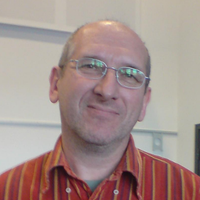
The Sensing Planet: Why The Internet Of Things Is The Biggest Next Big Thing
By: Rob van Kranenburg
Rob van Kranenburg outlines a brief history of the next big thing–the internet of things–and argues that U.S. industry and government should be taking a more active role in its evolution.
About a decade ago, I would stand in the middle of a square somewhere and imagine that everything I saw could and would one day be possibly connected.
In my mind that was not such a new idea. Animists in Africa and Asia have for centuries talked about “living” inanimate objects, believing that things had a soul and taking good care of them. Humans are meaning-making machines, so we invest inanimate landscapes and objects with all kinds of qualities that they cannot really possess.
Ten years on, that daydream is becoming a reality with the Internet of Things. Loosely defined as a global process to enhance all objects with some kind of digital address, IoT is already coming to you: to your home as the smart meter that will streamline all your electrical appliances; to your connected car that will have distance sensors and eCall to alert accidents; and to your body as a patch in an intelligent T-shirt or the Siemens hearing aid that aims to pick up the fire truck noise and soften it before you “hear” it. In terms of “the next big thing” this is as big as fire and the book.
And it’s inevitable. Why? Because a confluence of historical factors has come together to make what was once the domain of science fiction a reality. Let’s quickly take a look at those drivers.
The first factor dates all the way back to 1974: the ubiquitous barcode. This showed that standard organizations were able to synchronize data streams between competitors. The second is RFID, the friend-foe Near Field Communication technology brought under the penny cost by MIT around 2000. The third driver is the incredible cheapness of database storage needed to collect, store and work on trillions of ‘hits’ and pieces of data. In fact, by the end of the ’90s database costs were the largest barrier to the IoT. The fourth is IPV6, the Internet Protocol replacing IPV4. With it we can expect internet addresses in anything that has software in it: your toothbrush, coffee machine, fridge, washing machine. Technologically thus IoT is an ecology of barcodes, QR codes, RFID, NFC, active sensors, wifi and Ipv6. Nothing fancy; mostly radio, quite mundane.
The next factors in the IoT are more intangible than hardware and tech. In 1991, Mark Weiser, the father of ubiquitous computing published his groundbreaking text The Computer for the 21th Century, in which he argued that computers had gotten smaller, ubiquitous and faster yet he was still accessing his with a keyboard and a mouse. He wanted a more intuitive interaction with all the intelligence harnessed in the network of networked computers. He was talking about design and interactivity, which is the fifth factor in the IoT.
The sixth driver is us. Ourselves. We have jumped on the Internet, mobile phones, smartphones, iPads, social networks like no other technological invention before. We can not deny that as a species the drive is towards more connectivity, more awareness of where people and objects are and an ever-growing synergy between all the different applications and services, none of which can survive on its own any more.
The challenge we are facing today is not how can we stop or guide this process, as it is going so fast. No, the challenge is how can we make sure that this process that is inevitable is inclusive and open.
Read rest of article (emphasis added above).
See Also:
THE OPEN SOURCE EVERYTHING MANIFESTO: Transparency, Truth & Trust



